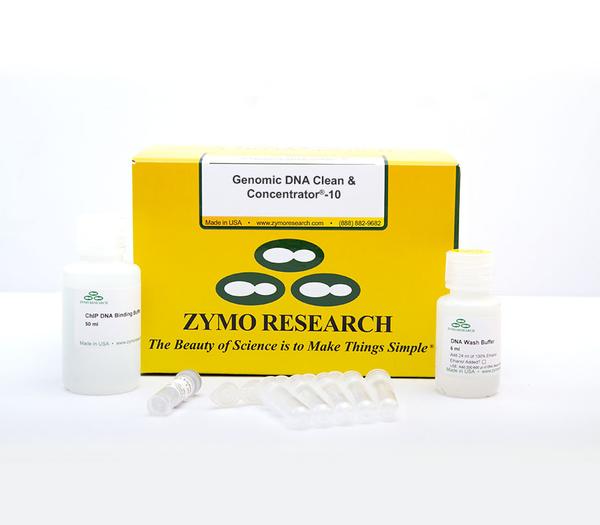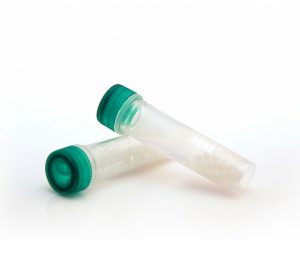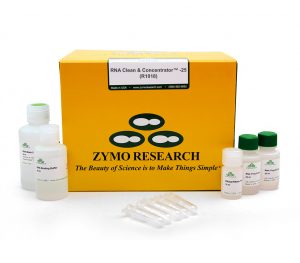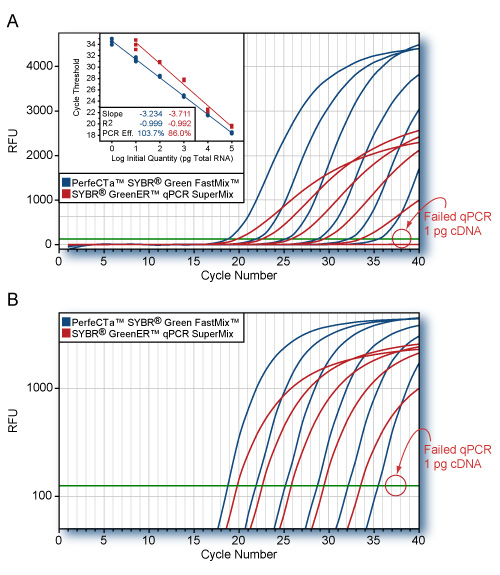DNA Clean & Concentrator-25
| Cat # | Name | Size |
|---|---|---|
| D4033 | DNA Clean & Concentrator-25 (Capped) | 50 Preps |
| D4034 | DNA Clean & Concentrator-25 (Capped) | 200 Preps |
| D4005 | DNA Clean & Concentrator-25 (Uncapped) | 50 Preps |
| D4006 | DNA Clean & Concentrator-25 (Uncapped) | 200 Preps |
Description
Highlights
- Quick (2 minute) desalting and recovery of ultra-pure DNA from enzymatic reactions (e.g., PCR and endonuclease digestions), cell-free lysates, etc.
- Column design allows DNA to be eluted at high concentrations into minimal volumes.
- Eluted DNA is well-suited for use in PCR, DNA sequencing, DNA ligation, endonuclease digestion, RNA transcription, radiolabeling, arrays, etc.
Description
The DNA Clean & Concentrator-25 (DCC-25) is a PCR purification kit designed for rapid desalting and purification of up to 25 µg DNA from enzymatic reactions (e.g., PCR), endonuclease digestions, or cell-free lysates. Simply add the specially formulated DNA Binding Buffer to your sample and transfer to the supplied Zymo-Spin column. This PCR purification kit features Zymo-Spin column technology to yield high-quality, purified DNA in just minutes, and it is compatible with cDNA and ssDNA. Eluted DNA is suitable for sequencing, microarray analysis, PCR, nucleotide blotting, and restriction endonuclease digestion procedures.
Detergent Tolerance
≤5% Triton X-100, ≤5% Tween-20, ≤5% Sarkosyl, ≤0.1% SDS
Elution Volume
2 mL screwcap tube pre-filled with DNA/RNA Shield (1 mL) and ultra-high density BashingBeads (R1103 – 0.5 mm & 0.1 mm beads, R1105 – 2.0 mm beads) for homogenization. R1104 includes swab with 20 mm breakpoint.
Elution Volume
Microcentrifuge
Purity
Highly-pure DNA is eluted with water and is especially well suited for sequencing, ligation reactions, and restriction endonuclease digestions.
Sample Source
Microcentrifuge
Purity
A260/A280 > 1.8, A260/A230 > 1.8
Sample Source
DNA from PCR, endonuclease digestions, DNA modification reactions, isotope/fluorescence labeling reactions, etc.
Size Range
50 bp to 23 kb
Yield
≤ 25 µg total DNA can be recovered. For DNA 50 bp to 10 kb the recovery is 70-90%. For DNA 11 kb to 23 kb the recovery is 50-70%.
Q1: What is the difference between capped and uncapped?
The only difference is the cap. Everything else between the columns (max capacity, column matrix, etc.) is the same. Unsure which to use? It mainly comes down to preference. Some people like the capped columns for easy labeling or added security while others like the uncapped columns for faster sample processing.
Q2: What is the minimum input volume of DNA sample?
Working with volumes below 50 µl can result in decreased recovery. Zymo Research recommends raising the starting volume to 100 µl with water to ensure optimal binding conditions.
Q3: How many times can columns be reloaded?
Zymo Research recommends reloading columns no more than 5 times, as binding efficiency might decrease.
Q4: What happens if more DNA was loaded on the columns than the stated maximum binding capacity?
Oversaturation of the column can result in total DNA loss due to clogging of silica matrix.
Q5: How can I process naked DNA stored in DNA/RNA Shield?
Use the standard protocol (add 2 or 5 volumes of DNA binding buffer depending on DNA size).
Q6: What is the lower limit and minimal amount of DNA that can be recovered?
Picogram levels of DNA can be recovered. The limitation is based on sensitivity of detection method.
Q7: What should I do if I did not add ethanol to the DNA Wash Buffer before starting?
The DNA will be eluted off the column during the wash step. Rebind samples using the appropriate amount of DNA Binding Buffer and wash the column with the properly prepared wash buffer.
 |
99 / 100 Bioz Stars |
SMARCA4 loss is synthetic lethal with CDK4/6 inhibition in non-small cel…
Nat Commun – Published 4 Feb 2019
‘no. 15027865), 16.5 µl PBS, 0.5 µl 1% digitonin, 0.5 µl 10% Tween-20, 5 µl H2 O) and incubated at 37 °C for 30 min in a thermomixer with 1000 RPM mixing. . After cleaning with Zymo DNA Clean and Concentrator-5 Kit (Zymo Research cat. no. D4014), eluted DNA was pre-amplified for 5 cycles using NEBNext 2x MasterMix (NEB cat. no. M0541).. Additional amplification cycles were added based on qPCR amplification .’
SLFN11 blocks stressed replication forks independently of ATR
Mol Cell – Published 01 Feb 2019
‘the transposase reaction mix [25 μl 2x TD buffer, 2.5 μl Transposase (Illumina) and 22.5 μl of nuclease free water], and incubated for 30 minutes at 37 °C. . Directly following transposition, the sample was purified using a DNA Clean and Concentrator-5 (ZYMO RESEARCH) and eluted with 25 μl of DNA elution buffer.. Following purification, we amplified library fragments using 1x NEBnext PCR master mix and 1.25 μM of custom Nextera PCR primers 1 and 2, using the ‘
TaME-seq: An efficient sequencing approach for characterisation of HPV g…
Sci Rep – Published 24 Jan 2019
‘Samples were subjected to tagmentation using Nextera DNA library prep kit (Illumina, Inc., San Diego, CA).. Tagmented DNA was purified using DNA Clean & Concentrator™-5 columns (Zymo Research, Irvine, CA) according the manufacturer’s instructions or ZR-96 DNA Clean & Concentrator™-5 plates (Zymo Research, Irvine, CA) according to the Nextera® DNA Library Prep Reference Guide (15027987 v01) before PCR amplification for target enrichment.. Amplification was performed using Qiagen Multiplex PCR Master mix (Qiagen, Hilden, Germany) according to the manufacturer’s instructions.’
“This kit performed as described. I was able to obtain good quality and yield of the DNA -better than with a couple of competitor’s kits.”
– Kathleen B. (SUNY-ESF)
“The simple steps and washing instructions were excellent. DNA was ready for use for PCR and gave strong results.”
– Tyler C.
“It only took 2 minutes for the total procedure – shorter than my current method of PCR purification.”
Marissa V. (Harvard Medical School)
“Almost no loss of elution buffer at the final step. It is quite impressive compared to the other kits I have used, which lose about 5-7µl.”
– Takashi K. (Monash University)
“I like the enhanced design of the column as it funnels every drop of volume directly through the silica in a very efficient manner. The quick spin times and relative ease of use are also a big draw as it cuts down on processing time and allows the attack of subsequent enzymatic steps at a heightened pace.”
– Joseph R. (Miller School of Medicine, University of Miami)
“I sampled this kit next to a kit we already use. I had three of the same sample, two for the Zymo kit and one for the other. On one of the ones designated for your kit, I accidentally added the sample directly to the column filter, then added other reagents (I figured I might as well try it). The other I did as per the instructions. The one on which I goofed gave a similar purification and concentration as the other kit, while the one I did properly yielded approximately four times the DNA per µL as the other kit. I am very happy with this result, and when I rerun my samples, I plan to use your product.”
– Rosalind P. (University of Arkansas for Medical Sciences)
“The elution volume is low enough to concentrate any sample very well and the efficiency is not compromised at all.”
– Shanshan L. (UT Southwestern)
“It was a very simple procedure and it gave a concentration ten times the original amount.”
– Kimberly M. (University of Pennsylvania)
| Cat # | Name | Size |
|---|---|---|
| D3004-4-10 | DNA Elution Buffer | 10 ml |
| D3004-4-4 | DNA Elution Buffer | 4 ml |
| D4003-1-L | DNA Binding Buffer | 50 ml |
| D4003-2-24 | DNA Wash Buffer (Concentrate) | 24 ml |
| D4003-2-6 | DNA Wash Buffer (Concentrate) | 6 ml |
| C1001-50 | Collection Tubes | 50 Pack |
| C1001-500 | Collection Tubes | 500 Pack |
| C1001-1000 | Collection Tubes | 1000 Pack |
| C1008-50 | Zymo-Spin II Columns | 50 Pack |
| C1008-250 | Zymo-Spin II Columns | 5 x 50 Pack |
| D4004-1-L | DNA Binding Buffer | 100 ml |
| C1078-50 | Zymo-Spin IICR Columns | 50 Pack |
| C1078-250 | Zymo-Spin IICR Columns | 5 x 50 Pack |










